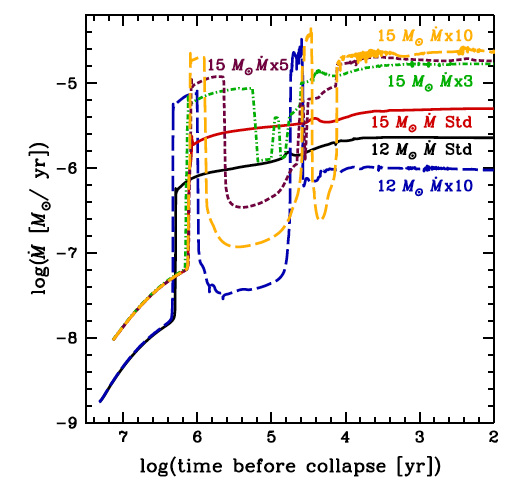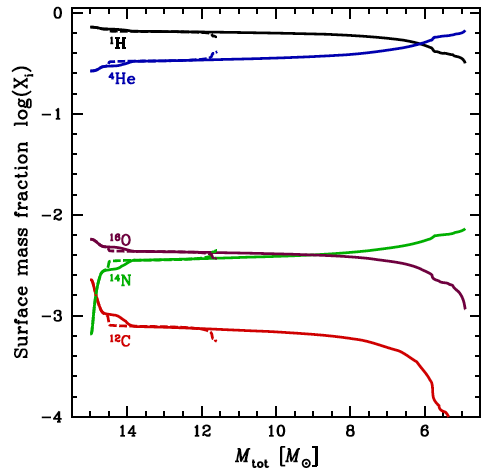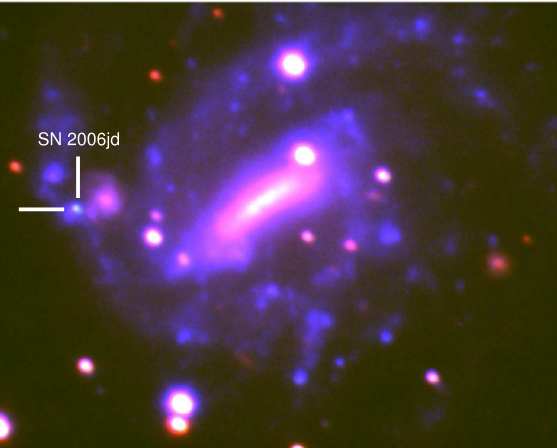• Title: Yellow supergiants as supernova progenitors: an indication of strong mass loss for red supergiants?
• Authors: Cyril Georgy
• First Author’s Institution: Centre de Recherche Astrophysique de Lyon, Ecole Normale Supéieure de Lyon, 46, allée d’Italie, F-69384 Lyon cedex 07, France
Massive stars (i.e, those with masses greater than 8 solar masses) end their lives in energetic explosions. These core collapse Supernovae (SNe) are caused by the stellar core, which is no longer supported by nuclear fusion, collapsing under its own weight. Observing these explosions and their associated progenitors (e.g., before and after pictures) can increase our understanding of how these stars evolve.
The spectral signatures and associated light curves of these core collapse SNe provide valuable information about the progenitor of the explosion. For example, if the light curve shows a plateau and its resulting spectra has strong hydrogen lines, we know that the progenitor must have had a massive hydrogen envelope. This resulting plateau in the light curve is a result of this envelope moving inwards toward the expanding ejecta of the SN explosion. However, the spectra of some SNe are devoid of hydrogen lines (e.g., type I), suggesting that the progenitor had lost its hydrogen envelope before it exploded, and others have very weak hydrogen lines suggesting that the progenitor must have lost most of its hydrogen envelope during its evolution. One way for a star to remove a substantial portion of its hydrogen envelope is with stellar winds.

Hertzsprung Russell diagram of the stellar evolutionary models with increased mass-loss rates. The initial stellar mass and mass-loss prescription is indicated near the tracks. The filled in circles represent the end points of the simulations. The right panel shows the zoomed in region where the end-points of the track lie. Black squares represent observational data of supernovae progenitors and the open red circles show the positions of observed red supergiants.
In this article, the author models the stellar evolution of rotating, massive stars which have initial stellar masses of 12 and 15 solar masses and high mass-loss rates during their red supergiant (RSG) stellar evolutionary phase. This evolutionary state occurs for stars with initial masses greater than ~10 solar masses during their helium burning phase. The mass-loss rates for this phase are highly uncertain and may even be underestimated. To account for this the author uses increased mass-loss rates which are a factor of 3-10 times larger than the standard mass-loss prescription used for RSG stars. These increased mass-loss rates may also explain why some SNe blow off most of their hydrogen envelope before they explode. They also assume that the initial composition of these stars is the same as that of the initial composition of the Sun. By following the stellar evolution, the author explores how the increased mass-loss rates affects the physical properties of the star before it explodes (i.e, its position in the Hertzsprung Russell (HR) Diagram) and the resulting type of SN.

Mass-loss rates of the models as a function of time for the last million years of the stellar life.
Previous work has shown that an increased mass-loss rate will cause more hydrogen to be ejected from the envelope prior to the core collapse of the progenitor star, leading to a smaller remnant mass, higher effective temperature, and smaller hydrogen content in the ejecta for more massive stars (e.g., stars with initial masses greater than 20 solar masses). The author finds a similar effect for his lower mass models. As can be seen in the figure above, the stars with an inital mass of ~15 solar masses which have the increased mass-loss rates (green, purple, and orange tracks for the mass-loss rates increased by a factor or 3, 5, and 10, respectively) show a similar behavior: they all become hotter as they climb the supergiant branch, causing them to loop around the bluer region of the HR diagram (i.e, have a higher effective temperature) and end up as a yellow supergiant when they explode. They also find that the greater the mass-loss rate, the hotter the star will become as it evolves on the HR diagram.
The figure on the right shows the mass-loss rate of the models as a function of time. This figure shows that the mass-loss rates are much greater when the stars enter the RSG phase as compared to their mass-loss rates while they are on the main-sequence for all models. As discussed above, the stars with the increased mass-loss rates will loop around the supergiant branch and get hotter and bluer. This causes the mass-loss rates to decrease as they loop around the blue supergiant region. However, as the stars get cooler their mass-loss rates increase and stay at a relatively constant value when they become yellow supergiants. Furthermore, the author also finds that the final stellar masses of the models with the increased mass loss rates are comparable since the duration of the blue loop is longer for stars with stronger mass-loss rates.

Logarithm of the mass fraction of certain elements (indicated by the labels) at the stellar surface as a function of the actual stellar mass of the star for the 15 solar mass star with the standard mass-loss rate (dashed line) and increased mass-loss rate (by a factor of 10) (solid line).
Looking back at the right panel of the first figure, we see that the end points of the models with increased mass-loss rates during the RSG phase end up as yellow supergiants before they explode. These positions agree with current observations of some peculiar SNe (black solid squares). The spectra and light curves of these SNe suggest that their progenitors must have an envelope with little hydrogen. As can be seen in the figure on the left, the models with the increased mass-loss rates (solid lines) lose more hydrogen from their surface as they evolve as compared to the standard mass-loss rate (dashed lines). The author thus concludes that RSGs with higher than expected mass-loss rates may be a possible progenitor for these types of peculiar SNe but how these high mass-loss rates are achieved remains an unanswered question.




